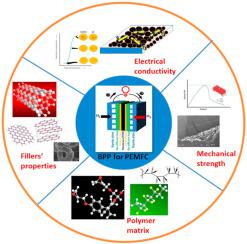Renewable and Sustainable Energy Reviews ( IF 15.9 ) Pub Date : 2020-11-10 , DOI: 10.1016/j.rser.2020.110535 Nazmus Saadat , Hom N. Dhakal , Jimi Tjong , Shaffiq Jaffer , Weimin Yang , Mohini Sain

|
Fuel cells in the near future are going to challenge the recent strong progress of the battery-based energy system. Despite many challenges, including material composition, storage and distribution, hydrogen fuel cell has demonstrated its potential in the trucking and fleet transportation systems due to its ability to be safely transported and used resulting in sharp drop in CO2 and particulate emissions. Review works revealed that Proton Exchange Membrane Fuel Cell (PEMFC) technology is reaching a commercialization phase for the fuel cell electric vehicles (FCEVs). Study further disclosed the need for a more focused investigation into materials' properties and plate design to enhance the efficacy of composite bipolar plates (BPP), specially their electrical and mechanical properties, as one of the main components of PEMFC. Carbon fiber, expanded graphite and carbon nanotubes are promising functional materials that can be utilized to enhance the performance of bipolar plates further by addressing their critical challenges such as agglomeration and poor thermodynamic compatibility. Conductive polymer embedded carbon nanomaterials showed high promise to improve the performance of PEMFC. Herein, the critical parameters affecting the introduction of carbon materials in fuel cell components are discussed with a focus on electrical, mechanical and durability performance of BPP. Recommendations are made related to cost vs performance for future development. This paper has also outlined the scope and future perspectives to fuel cell technology by reviewing the areas of recent developments with carbon-polymer based BPP as an attempt to highlight their potential commercial applications as high-performance bipolar plates for PEMFC.
中文翻译:

燃料电池用碳材料的最新进展和未来展望
在不久的将来,燃料电池将挑战基于电池的能源系统的近期强劲发展。尽管存在许多挑战,包括材料成分,存储和分配,但氢燃料电池由于能够安全运输和使用而导致CO 2急剧下降的能力,显示出了在卡车和车队运输系统中的潜力。和颗粒物排放。审查工作表明,质子交换膜燃料电池(PEMFC)技术正在进入燃料电池电动汽车(FCEV)的商业化阶段。研究进一步揭示了需要对材料的性能和板设计进行更集中的研究,以增强复合双极板(BPP)的功效,特别是其电学和机械性能,以此作为PEMFC的主要成分之一。碳纤维,膨胀石墨和碳纳米管是很有前途的功能材料,可通过解决其严重的挑战(例如团聚和差的热力学相容性)来提高双极板的性能。导电聚合物嵌入的碳纳米材料显示出改善PEMFC性能的高前景。在这里 讨论了影响燃料电池组件中碳材料引入的关键参数,重点是BPP的电气,机械和耐久性能。针对将来的开发提出了有关成本与性能的建议。本文还通过回顾基于碳聚合物的BPP的最新发展领域来概述燃料电池技术的范围和未来前景,以试图突出其作为PEMFC高性能双极板的潜在商业应用。



























 京公网安备 11010802027423号
京公网安备 11010802027423号